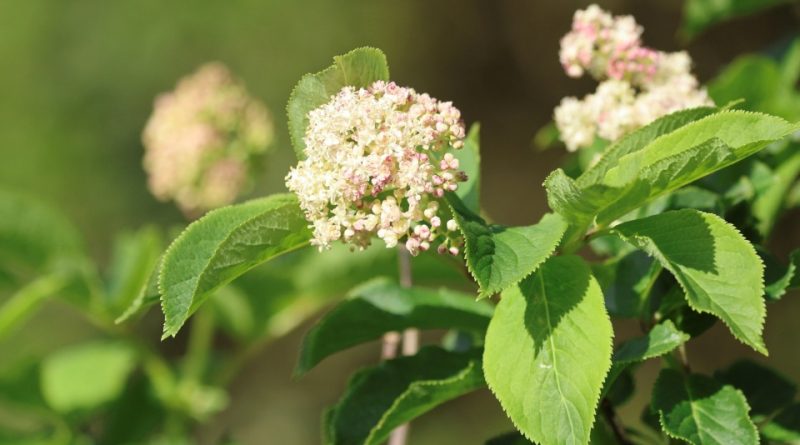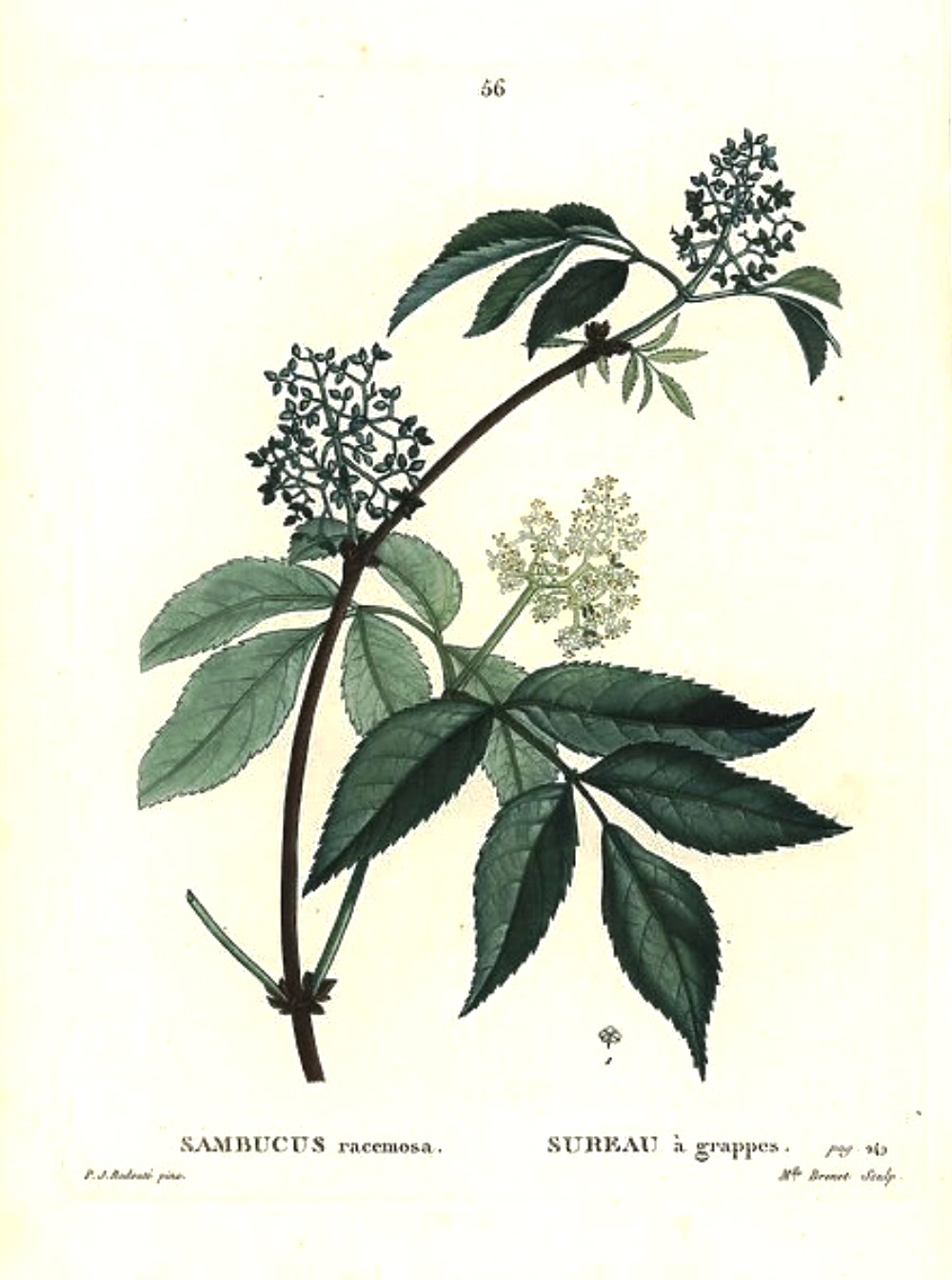Sambucus racemosa
Sambucus racemosa
The red elderberry or red-berried elder (Sambucus racemosa L., 1753) is a shrub species belonging to the Adoxaceae family.
Systematic –
From a systematic point of view it belongs to:
Eukaryota domain,
Kingdom Plantae,
Division Magnoliophyta,
Class Magnoliopsida,
Dipsacales Order,
Adoxaceae family,
Genus Sambucus,
Species S. racemosa.
The terms are synonymous:
– Sambucus arborescens Nutt. ex Torr. & A.Gray;
– Sambucus buergeriana var. glabra Nakai;
– Sambucus praecox Bernh.;
– Sambucus racemosa f. roseiflora (Carrière) Scoggan;
– Sambucus racemosa f. rosiflora (Carrière) B.Boivin;
– Sambucus racemosa var. glabra Miq.;
– Sambucus racemosa var. plumosa H.L.Späth;
– Sambucus racemosa var. plumosa H.L.Späth ex Carrière;
– Sambucus roseiflora Carrière.
Within this species the following subspecies, varieties and forms are recognised:
– Sambucus racemosa subsp. pubens (Michx.) Hultén;
– Sambucus racemosa subsp. racemosa L.;
– Sambucus pubens var. dimidiata Schwer., 1909;
– Sambucus pubens var. pubens;
– Sambucus pubens var. verrucosa Schwer., 1909;
– Sambucus racemosa var. laciniata A.Gray, 1884;
– Sambucus racemosa var. melanocarpa (A.Gray) Mc Minn;
– Sambucus racemosa var. racemosa L.;
– Sambucus racemosa f. laciniata (W.D.J.Koch ex DC.) House, 1923;
– Sambucus racemosa f. racemosa;
– Sambucus racemosa f. xanthocarpa House, 1923.
Etymology –
The term Sambucus comes from sambucus, the Latin name of the elderberry in Pliny and Columella; according to some, the Latin name derives from the Greek σαμβύκη sambúke sambuca, a stringed musical instrument that was supposedly made using elder wood; according to others due to the similarity of the epicormic shoots of the elderberry with the cords of the sambuca.
The specific epithet racemosa comes from racémus bunch, stem: with flowers and fruits arranged in a raceme.
Geographic Distribution and Habitat –
Sambucus racemosa is a plant native to Europe, northern Asia and North America (Canada and the United States).
Its habitat is that of clearings, on the edges of beech-maple or other species woods, in places with partial shade, in stony ground and along mountain slopes up to the limit of the vegetation of the trees from 800 to 2000 m above sea level. It can be found in the riparian zone, that is, along watercourses and generally forms scattered patches, although it can form thickets in some areas of its range. This plant in its natural habitat stands out for the color of its fruits, especially when combined with the dark green of fir and pine trees or the lighter green of beech and ash trees.
Description –
Sambucus racemosa is a deciduous plant that grows in shrub or tree form and reaches a height of approximately 2–6 m. The stems are soft with a medullary center.
The roots are very branched and extend up to 1 m deep. Sometimes rhizomes are present.
The leaves are downy, light green on the underside, opposite, deciduous, briefly petiolate, 10-25 cm long.
Each leaf is composed of 5-7 leaf follicles, each of which is 16 cm long, lanceolate to narrowly oval and irregularly serrated along the edges. The follicles have a strong unpleasant odor when crushed.
The inflorescence is panicle-shaped with a vaguely conical shape. The flower buds are pink when closed, while once bloomed the petals are white or yellowish. The flowers are fragrant and are pollinated by hummingbirds and butterflies. Each flower has small, curved petals and a star-shaped white axis of five-pointed stamens in yellow anthers. The flowers, which open in late spring and early summer, are fragrant and are visited by hummingbirds and butterflies.
The fruit is a bright red or sometimes purple drupe.
Inside there are 3 to 5 seeds. Dissemination is carried out by animals that ingest the fruits and release the seeds in their feces (endozoochonic dissemination).
Cultivation –
Sambucus racemosa is a deciduous shrub that is harvested from the wild for local use as a food, medicine and source of materials.
This plant is grown as an ornamental plant, to be used as a shrub or small tree in traditional and wild gardens and in natural landscape design interventions.
This species resists down to minimum temperatures of around -25 °C.
From a pedological point of view, it tolerates most soils, including chalky ones but prefers humid and clayey soils.
It tolerates some shade but prefers a sunny position. Prefers cool, moist conditions. It tolerates air pollution and coastal situations.
There are some named varieties of this species developed for their ornamental value.
The plant can be propagated vegetatively from dormant hardwood cuttings collected in the fall or winter and planted in moist soil as “living stakes,” or in the spring or summer from root or rhizome cuttings. All cuttings benefit from the use of a rooting hormone solution. It can also be easily reproduced using seeds. For good germination, dry or fresh seeds are placed in a warm, humid bed (20-30 °C) for 30-60 days, then in cold stratification (5 °C) for at least 90-150 days. Sowing is recommended between winter and spring.
Customs and Traditions –
Sambucus racemosa is a plant known by various names, including: “red elderberry”, “red-berried elder” (English), “saúco rojo” (Spanish).
The species previously belonged to the Caprifoliaceae family but, following genetic evidence, it was placed in the new Adoxaceae family.
The plant is poisonous but, in popular medicine, it is used for its purifying, carminative, purgative and diuretic properties. The crushed fresh leaves reduce swelling and serous swelling when applied to the joints. Herbal teas and decoctions of dried fruits are traditionally used to combat intestinal inflammation. The fruits, without the toxic stones, can only be eaten if cooked. They contain vitamin A and C and are suitable for the preparation of jams and, after fermentation, quality spirits.
The fruits were cooked in a variety of recipes by the indigenous peoples of America, including the Apache, Bella Coola, Gitxsan, Gosiute, Makah, Ojibwa, Quileute, Skokomish, and Yurok peoples.
In these locations it has been used as a traditional medicinal plant by Native Americans, including the Bella Coola, Carrier, Gitksan, Hesquiaht, Menominee, Northern Paiute, Ojibwa, Paiute, Potawatomi, Tlingit, and Haida peoples. Uses included as an emetic, antidiarrheal, cold and cough remedy, dermatological and gynecological aid, and homostasis.
From an ecological point of view, the fruits are appreciated by birds, who also distribute the seeds. The flowers attract butterflies and hummingbirds.
Among other uses, remember that the leaves are used to repel insects.
Wood is commonly used in the production of various household items. It can also be hollowed out to make flutes, pipes, straws, etc.
Preparation Method –
Sambucus racemosa is a plant used by various populations for both food and medicinal purposes, as well as for ornamental purposes or for the recovery of some habitats.
The fruit of this species is known to cause stomach upset in some people. Any toxins the fruit may contain may have very low toxicity and are destroyed when the fruit is cooked.
According to some, this species has the tastiest fruit of this genus which is somewhat reminiscent of red currants even though the fruit is noticeably smaller and contains many seeds. It is rich in vitamin C, the seed can be removed and the fruit used in jellies, preserves etc.
When consuming these fruits it is reiterated to eat them cooked and it is also advisable to remove them before eating the fruit.
The flowers were eaten raw or cooked.
In medicinal vampo this species was widely used medicinally by various native tribes of North American Indians, who used it to treat a variety of ailments, but especially as an emetic and purgative to cleanse the system. However, it is little used in modern herbalism.
The leaves, stems and roots are anodyne, carminative and vulnerary.
A decoction is used in the treatment of traumatic injuries, fractures, rheumatoid arthralgia, gas pains, acute and chronic nephritis.
The fruit is purifying and laxative.
The leaves are diuretic, resolving and sweat-producing. They are used externally to soothe abscesses and boils.
The root and oil of the seed are emetic and purgative.
An infusion of the root is used to treat stomach pain.
The roots can be rubbed into the skin to treat sore and tired muscles.
Guido Bissanti
Sources
– Acta Plantarum – Flora of the Italian Regions.
– Wikipedia, the free encyclopedia.
– GBIF, the Global Biodiversity Information Facility.
– Useful Tropical Plants Database.
– Conti F., Abbate G., Alessandrini A., Blasi C. (ed.), 2005. An annotated checklist of the Italian vascular flora, Palombi Editore.
– Pignatti S., 1982. Flora d’Italia, Edagricole, Bologna.
– Treben M., 2000. Health from the Lord’s Pharmacy, Advice and experiences with medicinal herbs, Ennsthaler Editore.
Photo source:
– https://inaturalist-open-data.s3.amazonaws.com/photos/262452440/original.jpeg
Attention: Pharmaceutical applications and food uses are indicated for informational purposes only, they do not represent in any way a medical prescription; we therefore decline any responsibility for their use for healing, aesthetic or food purposes.


